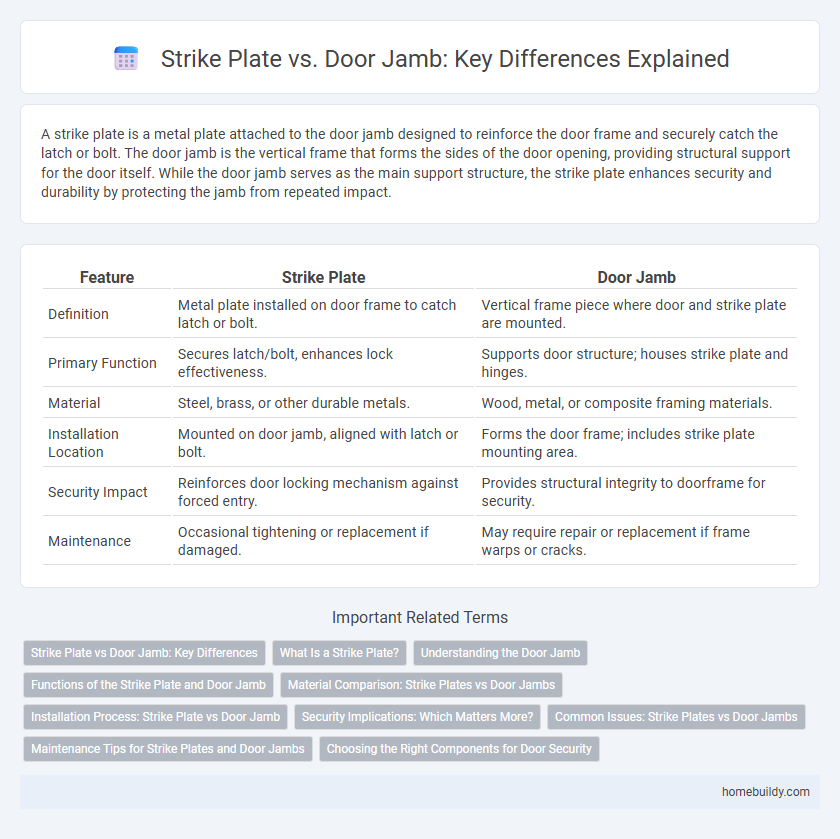A strike plate is a metal plate attached to the door jamb designed to reinforce the door frame and securely catch the latch or bolt. The door jamb is the vertical frame that forms the sides of the door opening, providing structural support for the door itself. While the door jamb serves as the main support structure, the strike plate enhances security and durability by protecting the jamb from repeated impact.
Table of Comparison
| Feature | Strike Plate | Door Jamb |
|---|---|---|
| Definition | Metal plate installed on door frame to catch latch or bolt. | Vertical frame piece where door and strike plate are mounted. |
| Primary Function | Secures latch/bolt, enhances lock effectiveness. | Supports door structure; houses strike plate and hinges. |
| Material | Steel, brass, or other durable metals. | Wood, metal, or composite framing materials. |
| Installation Location | Mounted on door jamb, aligned with latch or bolt. | Forms the door frame; includes strike plate mounting area. |
| Security Impact | Reinforces door locking mechanism against forced entry. | Provides structural integrity to doorframe for security. |
| Maintenance | Occasional tightening or replacement if damaged. | May require repair or replacement if frame warps or cracks. |
Strike Plate vs Door Jamb: Key Differences
Strike plates and door jambs serve distinct functions in door security and installation; the strike plate is a metal plate fastened to the door jamb that reinforces the latch or bolt's entry point, while the door jamb is the vertical frame forming the sides of a door frame. The strike plate's primary role is to absorb impact and distribute the force when the door is closed or locked, preventing damage to the door jamb and enhancing lock strength. In contrast, the door jamb provides structural support for the door, housing the strike plate and hinges to ensure proper door alignment and stability.
What Is a Strike Plate?
A strike plate is a metal plate affixed to a door jamb that reinforces the frame where the latch or deadbolt secures the door. It serves as a critical component in door security by absorbing and distributing the force when the door is closed or locked. Unlike the door jamb, which is the vertical framework holding the door, the strike plate provides a durable surface that ensures the latch or bolt engages properly for effective locking.
Understanding the Door Jamb
The door jamb is the vertical framework that holds the door in place and provides structural support for the strike plate, which is mounted on it. Understanding the door jamb's material and dimensions is crucial for selecting the appropriate strike plate to ensure proper latch alignment and enhanced security. Proper installation within the door jamb maximizes door functionality and prevents misalignment issues.
Functions of the Strike Plate and Door Jamb
The strike plate provides a reinforced metal surface on the door jamb, ensuring the latch or bolt securely engages to keep the door closed and locked. The door jamb serves as the structural frame supporting the hinge and strike plate, maintaining door alignment and stability. Together, they work to enhance door security, durability, and proper functionality by distributing impact forces and resisting forced entry.
Material Comparison: Strike Plates vs Door Jambs
Strike plates are commonly made from durable metals such as stainless steel or brass to withstand repeated impact, while door jambs are typically constructed from wood, metal, or composite materials that provide the primary structural support. The metal composition of strike plates ensures enhanced resistance to wear and forced entry, contrasting with the door jamb's role in framing and stabilization. Choosing the right material for each component improves security and longevity in door hardware systems.
Installation Process: Strike Plate vs Door Jamb
The installation process of a strike plate involves aligning and securing the metal plate onto the door jamb where the latch or bolt extends, requiring precise positioning to ensure proper door locking and security. In contrast, installing or repairing a door jamb typically involves woodworking skills to fit, repair, or replace the frame structure that supports the door and strike plate. Proper installation of both components is crucial for door functionality, with the strike plate providing reinforcement and the door jamb offering structural support.
Security Implications: Which Matters More?
The strike plate reinforces the door jamb by anchoring the locking mechanism and absorbing impact during forced entry attempts, making its strength crucial for security. A reinforced door jamb without a properly installed, heavy-duty strike plate can still be vulnerable to kick-ins and prying attacks. Prioritizing both a high-grade strike plate and a solid door jamb, often made of hardwood or metal, maximizes intrusion resistance and overall door security.
Common Issues: Strike Plates vs Door Jambs
Common issues with strike plates include misalignment, causing latch or deadbolt problems that prevent proper door locking. Door jambs often suffer from wear and structural damage due to repeated impact and weather exposure, which can compromise the integrity of the strike plate installation. Ensuring the strike plate is securely fastened to a solid door jamb minimizes security risks and prolongs door functionality.
Maintenance Tips for Strike Plates and Door Jambs
Regular inspection of strike plates and door jambs prevents misalignment and wear, ensuring optimal door security. Clean strike plates with a mild detergent and check for loose screws, tightening them to maintain proper function. Applying lubricant to the strike plate and ensuring the door jamb is free from cracks or damage extends the lifespan of both components.
Choosing the Right Components for Door Security
Selecting between a strike plate and a door jamb is crucial for enhancing door security. A strike plate reinforces the door frame by absorbing the impact from door locks, while the door jamb provides structural support and houses the strike plate. Opting for a heavy-duty strike plate combined with a solid door jamb improves resistance against forced entry and strengthens overall security.
Strike plate vs door jamb Infographic

 homebuildy.com
homebuildy.com